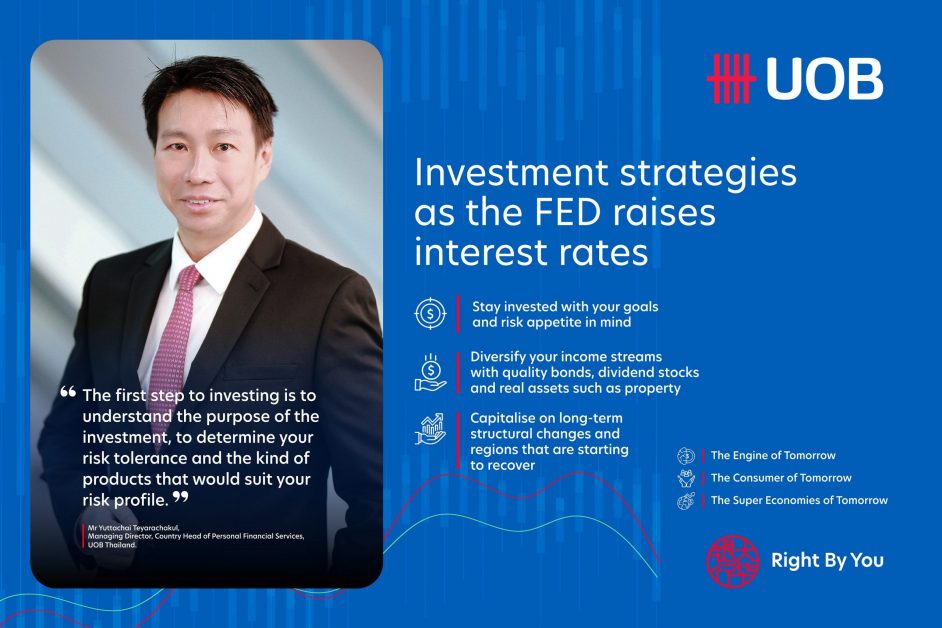After raising interest rates by three-quarters of a percentage point for the third time in as many months, Federal Reserve Chair, Jerome Powell, said to rein in inflation without starting a recession, the FED lifted its key lending rate to a target range of 3 per cent to 3.25 per cent as part of the most aggressive tightening since the 1980s.
Still, the US economy has entered a technical recession, with the recently released second-quarter Gross Domestic Product (GDP) data indicating a 0.9 per cent fall. GDP fell by 1.6 per cent in the first quarter, which means the US economy has now contracted for two straights quarters. Our view at UOB is we are expecting the economy to slow down, followed by a shallow recession. As household balance sheets remain healthy and borrowings are not excessive, any recession would probably be mild. Most importantly, we are in the late stage of the economic cycle with slower growth, and it is time to be defensive. These are key takeaways for investors.
Stay invested with your goals and risk appetite in mind
The first step to investing is to understand the purpose of the investment, to determine your risk tolerance and the kind of products that would suit your risk profile. Figuring out financial goals can help determine the investing time frame, and thus the risk level that an investor is willing to endure given the volatility in the value of an investment.
Diversify your income streams with quality bonds, dividend stocks and real assets such as property
High-quality bonds with at least a BBB rating that are issued by companies with sound fundamentals, low borrowings and a diversified revenue stream are a good option. These companies tend to have stronger cash flow positions and better repayment ability to provide stable income for investors. Real assets like infrastructure, properties and Real Estate Investment Trust (REIT) are other means of diversifying income streams can generate income for investors. Hence investors can consider these assets in addition to the typical fixed income and equities as alternate options for income.
Capitalise on long-term structural changes and regions that are starting to recover
While the global economy may be affected by interest rate hikes and recession risks, investors could focus on investing in longer-term structural trends for a more stable ride. We think there are three megatrends that are the dominant forces impacting the investment landscape now and driving the world of tomorrow.
The Engine of Tomorrow -The engine of tomorrow includes the development of clean and renewable energy to tackle climate change and technologies that are driving accelerated growth and transformation across all sectors of the global economy. Investors can consider investing in technologies that help mitigate climate change and facilitate energy transition as well as companies that benefit from adopting artificial intelligence.
The Consumer of Tomorrow - Changing demographics are leading to shifts in consumer preferences and behaviours, which in turn affect generational spending patterns. The increasingly affluent middle class in developing economies will lead to greater demand for better-quality goods and services. Meanwhile, some countries are also facing ageing populations, which means there will be increased spending on healthcare-related goods and services. As generational shifts take place, companies will have to reorient their strategies and priorities to meet the needs of millennials and Generation Z - digital natives who value sustainability and social responsibility. Investors can consider investing in businesses that grow their digital outreach sustainably to benefit from changing consumption patterns.
The Super Economies of Tomorrow - The strategic rivalry between the leading super economies of this century - the US and China - often exert influence and set global standards over the regulatory frameworks, economic policies and market dynamics of other countries. The breadth and depth of their financial markets provide an opportunity for investors to pursue returns on both sides of the spectrum as part of a diversified portfolio. Investing in both the US and China will provide exposure to broad and deep financial markets.
Investors must be aware of their risk appetites and maintain a diversified portfolio to mitigate risks due to unforeseen events. UOB's proprietary Risk-First approach can help smoothen the ride by recommending a suitable investing strategy for a diversified portfolio that is in line with each investor's risk appetite. Before coming to any investment decision, investors should always ensure that they are clear about what they are investing in and have considered the potential risk factors
Source: United Overseas Bank (Thai)
